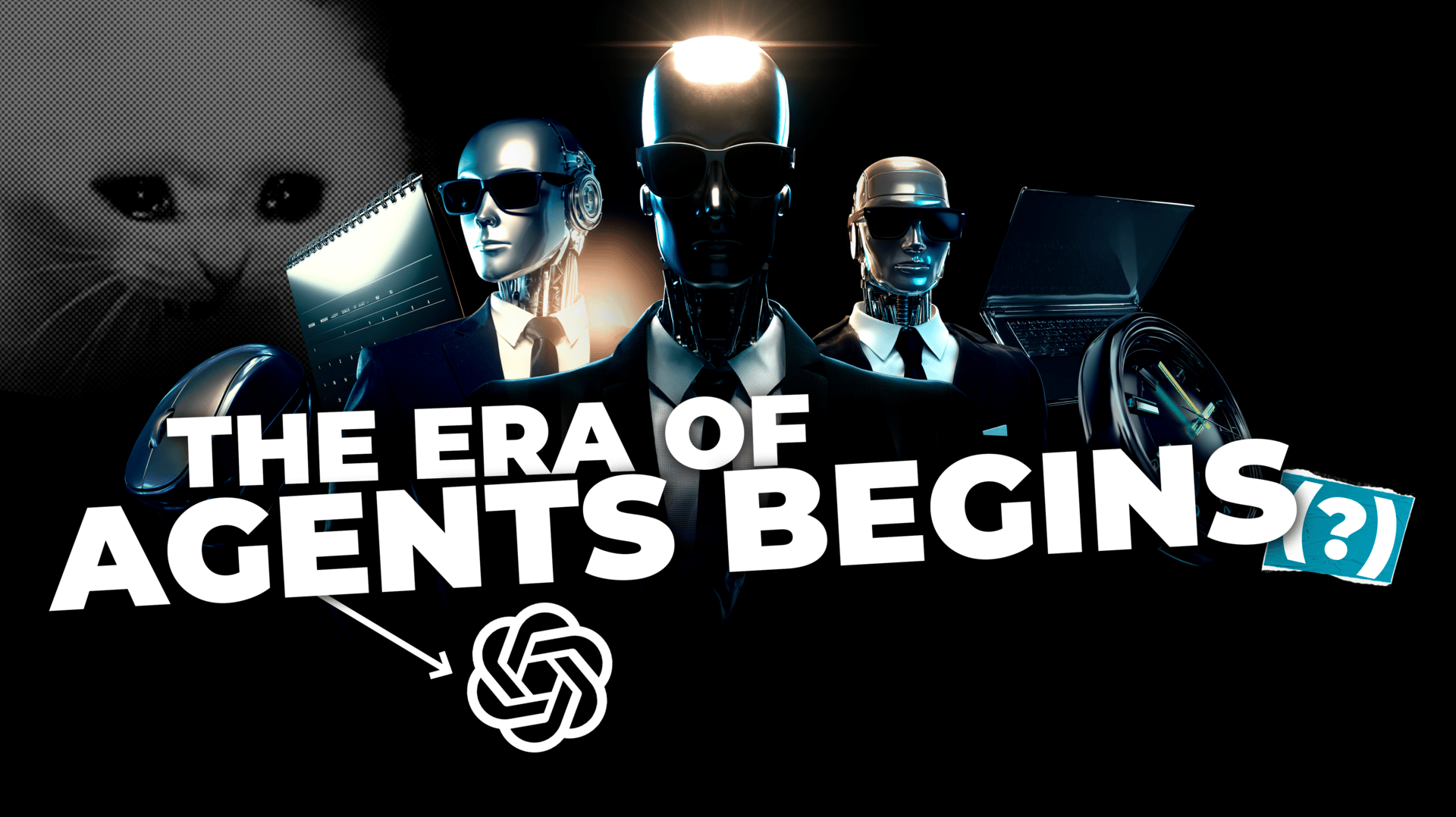- Failory
- Posts
- Demo Day Disaster
Demo Day Disaster
How CodeParrot left YC empty-handed and never recovered.
Hey — It’s Nico.
Welcome to another Failory edition. This issue takes 5 minutes to read.
If you only have one, here are the 5 most important things:
CodeParrot, a startup that wanted to automate front end development, has shut down— learn why below.
Build your personal AI copilot
Netflix starts using GenAI in its shows and films
Coinbase Co-Founder raises $100M for brain Interface startup
OpenAI just launched ChatGPT agent, and it is really powerful — learn more below.
This Week In Startups
🔗 Resources
Build your personal AI copilot
How to get recommended by ChatGPT
40 things we’ve learned about marketing for developers
📰 News
Reflection AI launches Asimov, a breakthrough Agent for code comprehension
Netflix starts using GenAI in its shows and films
Google’s AI Overviews have 2B monthly users
Lovable AI hits $100M ARR in record time
💸 Fundraising
Robot guard dogs help Asylon raise a $26M Series B
Coinbase Co-Founder raises $100M for brain Interface startup
Space-tech startup Inbound Aerospace raises $1M
Multimodal AI startup Reka AI raises $110M
Fail(St)ory

Figma-to-Code OG
By 2022, dozens of AI startups were racing to automate front-end work. Among them, CodeParrot offered to turn Figma designs into code in seconds.
They raised $500 K, demoed at YC’s Winter ’23, and ran a year-long private beta. Yet two and a half years in, they’re shutting down. It’s a stark reminder: in this AI race, most startups won’t make it to the finish line.
What Was CodeParrot:
CodeParrot kicked off in early 2022 with a simple mission: stop wasting hours hand-coding UI from Figma mockups.
Founders Vedant Agarwala and Royal Jain built a VS Code plugin that spoke straight to Figma’s API, pulled down frames, styles, and layout info, then fed that into an LLM. In theory, you clicked “generate” and—boom—React, Flutter, or plain HTML appeared in your editor, complete with your own components and naming rules.
They pitched “Ship stunning UI lightning fast” at YC’s Winter ’23—and earned their spot in the batch. But when Demo Day arrived, the make-or-break showcase for follow-on checks, they walked away with zero commitments. That miss cut off their lifeline: just $500 K in the bank and no fresh capital. Agarwala later called what followed “pivot hell,” where every update had to prove itself or risk shutting down.
In that roughly year-long private beta, they cycled through multiple versions: doubling down on Figma-to-code, flirting with API-automation features, even planning an open-source launch. Each shift chased user feedback but chipped away at their original story. By the time they circled back to their core promise—effortless code from designs—their runway had almost vanished.
Meanwhile, the market got brutal. Anima had quietly been exporting Figma to React and Vue for years. Vercel rolled out V0 for generative UIs. Lovable raised serious rounds building a no-code drag-and-drop layer on top of designs. And just last quarter, Figma itself launched “Make,” its own AI code-export feature. Automating front-end work has become one of the hottest—and most crowded—corners of AI. CodeParrot was no lone pioneer but part of a relentless stampede.
The Numbers:
📅 Founded: 2022
💰 Seed: $500 K
🚀 YC Batch: Winter ’23
💸 Peak MRR: ~$1.5 K
Reasons for Failure:
No Follow-On Funding: Demo Day didn’t spark another round. With only $500 K in the bank, every salary and server dollar felt like borrowed time. Once runway hit six months, urgency spiked. Without fresh capital, even promising demos couldn’t keep the lights on.
Pivot Hell: They chased every lead. UI codegen, API tracing, performance dashboards. Each shift required fresh builds, docs, and marketing. That constant retooling drained momentum and confused users. By the time they refocused on Figma-to-code, the original story felt watered down.
Fierce Platform Power. In the design-to-code arena, distribution is everything—and CodeParrot never cracked the channel. Figma developers discover tools through the official plugin store, and Vercel users get V0 baked right into their dashboard. Lovable tapped Builder.io’s marketplace to put a no-code layer in front of designers. Without those built-in homes, CodeParrot faced far higher acquisition costs and churn, as teams defaulted to the path of least resistance.
Integration Friction: The AI could crank out code, but real projects brought edge cases. Custom components, unique styling, and business logic often broke the output. Engineers spent as much time cleaning and refactoring as they saved. That gap between promise and reality killed the “minutes, not days” pitch.
Why It Matters:
Differentiate or Integrate. In a crowded field, you need a distinct value prop or deep platform hooks to stick.
Resist Pivot Overload. Every new direction demands fresh marketing, docs, and engineering effort. Limit pivots to ones backed by clear user signals and defined success metrics.
Trend

GPT Agent
OpenAI just dropped its latest upgrade to ChatGPT: ChatGPT agent—and it’s designed to shoulder a whole new class of digital chores for you.
Think of it as combining the web-surfing chops of Operator with the deep-diving research finesse of Deep Research, all wrapped into one smoother experience. Whether you need your calendar scanned against the latest news, competitor intel compiled into a slide deck, or even groceries ordered for a themed brunch, this agent aims to handle it without you having to switch modes or tools.
ChatGPT can now do work for you using its own computer.
Introducing ChatGPT agent—a unified agentic system combining Operator’s action-taking remote browser, deep research’s web synthesis, and ChatGPT’s conversational strengths.
— OpenAI (@OpenAI)
5:53 PM • Jul 17, 2025
Why It Matters:
One interface, endless possibilities: Instead of toggling between separate agent modes, you now get a single assistant that picks the right tool for each task.
A wake-up call for vertical AI startups: If you’ve been betting on niche agents for your industry, this move shows how a generalist AI can absorb many of those use cases—fast.
SOTA benchmarks. The new agent scores 41.6% on Humanity’s Last Exam—about double prior GPT models—so you’re getting a noticeably smarter assistant from day one.
A Swiss Army Knife for Your Workflows
At its core, ChatGPT agent is Operator + Deep Research, seamlessly bridged by a lightweight “virtual computer” that picks the right tool for each step:
Visual browser (Operator): When you need human-like interaction—clicking buttons, logging in, filling forms—the agent fires up its GUI browser and navigates sites just like you would.
Text browser (Deep Research): For skimming long articles, parsing tables, or running bulk searches, it switches to a text-only view. No flashy interface—just pure data, fast.
Terminal: Behind the scenes, it can run shell commands, manipulate files, or crunch numbers. Perfect for transforming a downloaded CSV into a cleaned dataset without you lifting a finger.
API connectors: Need Gmail threads, Calendar events, or GitHub repos? With a quick connector hookup, the agent pulls in exactly what you ask for—no manual exports required.
Here’s why it rocks: you issue a simple prompt—“Compare our top three competitors and build me a slide deck”—and the agent internally asks:
“Should I click through their websites? Or pull data via API? Maybe run some code to clean it up?”
Once it picks the best path, it double-checks with you, then gets to work. At any moment you can jump in, nudge it, or hit stop. No more juggling separate modes or guessing which tool to use—ChatGPT agent figures it out for you.
Some Examples
It can find you the best trenchcoats under $500 in any store.
BREAKING: OpenAI has officially released Agent Mode, allowing users to spin up a virtual desktop and take action.
I got early access to ChatGPT Agent Mode and want to share my thoughts.
Agent Mode lets you delegate tasks like searching or browsing to an agent inside a virtual
— Allie K. Miller (@alliekmiller)
5:05 PM • Jul 17, 2025
It can read all your businesses emails and detect what users like and dislike.
ChatGPT Agent is WILD
i asked it to identify our core customer (and our biggest missing features) for @CoraComputer
it scanned through > 1,500 support emails, and hundreds of support forum posts to pull together a full report on who loves us, who hates us, and why.
it even
— Dan Shipper 📧 (@danshipper)
5:07 PM • Jul 17, 2025
It can make you a custom early retirement plan.
BREAKING: OpenAI just launched ChatGPT Agent
It allows ChatGPT to think, plan, and execute complex tasks on its own virtual computer while you do other things
I had early access, and ChatGPT Agent built me a complete early retirement plan in 20 minutes:
> Found local tax laws
— Rowan Cheung (@rowancheung)
5:21 PM • Jul 17, 2025
Vertical AI In The Hot Seat
Remember when everyone raced to build a one-trick AI pony—real-estate lead gen here, contract review there? Those days just got trickier. GPT Agent can already tackle a huge chunk of those niche tasks out of the box.
So what’s a vertical AI startup to do? You’ve got to bring more to the table than a clever prompt:
Proprietary edge. Own data nobody else has. If your insights come from exclusive feeds or hard-won partnerships, the Agent can’t replicate them.
Deep integrations. A simple API call won’t cut it. Embed workflows so tight that clients can’t imagine swapping you out.
Regulatory edge. Compliance isn’t just a checkbox—it’s a moat. Build in audit trails, approvals, and guardrails that go beyond what generalist AI offers.
Help Me Improve Failory
How Was Today's Newsletter?If this issue was a startup, how would you rate it? |
That's all of this edition.
Cheers,
Nico